[ Chapter 1 ] [ Chapter 2 ] [ Chapter 3 ] [ Chapter 4 ] [ Chapter 5 ] [ Chapter 6 ] [ Chapter 7 ] [ Index ]
Chapter 3 - System Support for Mobile Wirless Computing
Introduction
Support for:
Disconnected Operation
Can be described as a transition between three states [42] 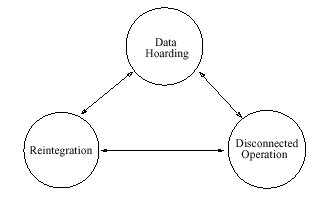
Data Hoarding State
Data items needed for operation are preloaded into the mobile unit.
Simply relocate data: inaccessible to other sites Replicate or cache data: consistency control
Type of data objects: depends on the application and the underlying data model.
For foreseeable disconnections, performed just before the disconnection. Else, on a regular basis, e.g., periodically.
How to anticipate future needs
- users explicitly specify which data
- use past history of data accesses
- based on the application for which the system will be used
Disconnected Operation
Disconnected State
Use only locally available data
Requests for other data may be inserted in an appropriate queue to be serviced upon reconnection. Applications with unsatisfied data requests can either suspend execution or continue working on some other job.
Regarding updates: - Pessimistic approach: updates only at one site (lock or checkin/checkout) - Optimistic approach: updates at more than one site but conflicts.
- Updates at the mobile unit are logged in client's stable storage. What information to keep in the log for effective reintegration and log optimizations
Keep the size of the log small to: (a) save memory, and (b) reduce the time for update propagation and reintegration at reconnection. Optimization either (a) during disconnected operation, incrementally each time a
new operation is inserted in the log, or (b) as a preprocessing step before propagating or applying the log upon reconnection.
Reintegration State
Updates at the mobile host are reintegrated with updates at other sites by reexecuting the log at the fixed host.
Summary
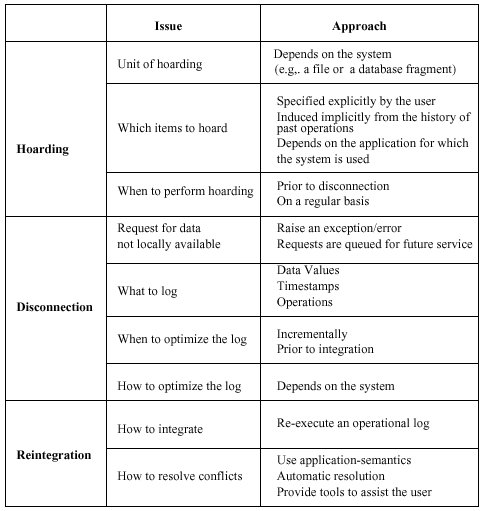
DO in File Systems
Extend caching to handle disconnections Hoarding vs Prefetching - prefetching is an ongoing process that transfers to the cache soontobeneeded files during periods of low network traffic. thus, keeping its overhead low is important.
- hoarding is more critical than prefetching. Thus, hoarding tends to overestimate the client's need for data. (although, excessive estimations cannot be satisfied) Unit of Hoarding:
ranges from a disk block, to a file, to groups of files or directories When to Hoard The Coda file system
Which Files to Hoard - In Coda - A treebased method - Seer Cache Misses During Disconnection
- treated as errors and raise exceptions Log Optimizations - In Coda, a replay log that records all corresponding system call arguments as well as the version state of all objects referenced by the call
- The Little Work project Conflicting Updates
- Cache updates are considered tentative. - In Coda, the replay log is executed as a single transaction. All objects referenced in the log are locked.
Different strategies for handling concurrent updates on files and on directories - Directory resolution fails only if a newly created name collides with an existing
name, if an object updated at the client or the server has been deleted by the other, or if directory attributes have been modified at the server and the client
- File resolution is based on applicationspecific resolvers (ASRs) per file - Only write/write conflicts are considered
DO in Database Systems
Granularity of Hoarding - In relational database systems, ranges from tuples, to set of tuples, to whole relations. - In objectoriented database systems, at the object, set of objects or class
(extension) level. Hoard by Issuing Queries - prefetch the data objects that constitute the answer to a given query. - corresponds to loading on the mobile unit materialized views
- operation during disconnection by posing queries against these views Which Items to Hoard - or how to identify which views to materialize, or specify the hoarding queries
- users may explicitly issue hoarding queries - use the history of past references to deduce dependencies among database items is hard - issues related to integrity and completeness - In Hoard Keys
An extended database organization: a set of hoard keys along with the primary and secondary key for each relation. Hoard keys capture typical access patterns of
mobile clients. Each hoard key partitions the relation into a set of disjoint logical horizontal fragments. Hoard fragments constitute the hoard granularity. The hoard keys can either be logical or physical.
Network Partition vs DO Network partition: a network failure partitions the sites of a distributed database system into disconnected clusters. Various approaches - In network partition, transactions executed at any partition of equal importance
while, in mobile computing transactions at the mobile host most often consider secondclass. - frequency of disconnections, network partitions correspond to failure behavior,
- some disconnections in mobile computing can be considered foreseeable. Tentative Commitment Tentatively commit transactions at a disconnected unit and make their results visible
to subsequent transactions in that unit. Upon reconnection, a certification process, during which the execution of any tentatively committed transaction is validated against an application or system
defined correctness criterion. If the criterion is met, the transaction is committed. Otherwise, it must be aborted, reconciled or compensated.
Such actions may have cascaded effects on other tentatively committed transactions. Isolationonly transactions (IOTs) An IOT is a sequence of file access operations. A transaction T is called a firstclass
transaction if it does not have any partitioned file access, i.e., the client machine maintains a connection for every file it has accessed. Otherwise, T is called a secondclass transaction.
The result of a firstclass transaction is immediately committed to the servers. A secondclass transaction remains in the pending state till connectivity is restored.
Its result is held within the client's local cache and visible only to subsequent accesses on the same client. They are guaranteed to be locally serializable among themselves.
A firstclass transaction is guaranteed to be serializable with all transactions previously resolved or committed at the server. Upon reconnection, a secondclass transaction T is validated against one of two
proposed serialization constraints: global serializability, or global certifiability. Transactions that cannot meet these criteria are resolved incrementally, i.e., one by
one, according to their local serialization order. An invalidated transaction is aborted, reexecuted or an ASR is automatically invoked. Manual resolution or repair is left as a last resort. TwoTier Replication
Replicated data have two versions at mobile nodes: master and tentative versions. A master version records the most recent value received while the site was connected. A tentative version records local updates.
Two types of transactions. A tentative transaction works on local tentative data and produces tentative data. A base transaction works only on master data and produce
master data. Base transactions involve only connected sites. Upon reconnection, tentative transactions are reprocessed as base transactions. If
they fail to meet some applicationspecific acceptance criteria, they are aborted and a message is returned to the mobile node.
DO in Workflow Systems
Workflow processes
: longrunning tasks involving the coordinated execution of multiple activities performed by different processing entities. Relevant terms: activities, data containers, rules or transition conditions
Workflow Management System: provides a (a) modeling tool to represent business processes via workflows and (b) a runtime system to coordinate and execute them in a heterogeneous and distributed environment.
Workflow execution and disconnected operation have contradictory goals Note: The processing entities where the activities are executed are distributed, but
the workflow system that coordinates their execution may be centralized or distributed. Disconnections among the processing entities also called clients.
What functionality should be placed on disconnected clients. Replicating part of the functionality of the workflow server on disconnected clients complicates operation
significantly especially since some applications may involve thousands of clients - The Exotica workflow system assigns no additional functionality to disconnected clients.
Pessimistic approach: prior to disconnection, a client reserves by locking the activities it plans to work on and hoards the relative to the activities data. Implementation based on worklists. A workitem
is an activity that belongs to a workflow process being executed. A worklist is a list of workitems associated with a user. Every time an activity is eligible for execution, it is broadcasted to the worklist of the
users associated with this activity. When a user selects an activity from its worklist, the activity is deleted from all other worklists and is associated with that user.
Before disconnection, a user selects from its worklist and locks the activities to work with plus the input data container. During disconnection, it works only on the activities it has locked. When the
execution of an activity terminates, its results are stored locally in client's stable storage. Upon reconnection, the results of all terminated activities are reported back to the server to be stored in the central database. The pessimistic approach taken by Exotica is justified by the high degree of data sharing in workflows and cooperative work. Else need for a sophisticated activity merging mechanism, e.g., history merging INCAS A new workflow model based on mobile agents called Information Carriers (INCAs). INCAs are mobile agents that model a workflow process. There is no centralized
workflow server. Instead, each INCA controls its own execution. In particular, each INCA encapsulates the private data of the workflow, a set of rules that control the flow between the activities of the INCA computation, and the
history (log) of its execution. Each INCA is initially submitted to a processing entity, and roams among processing entities to achieve its goal. Being mobile agents, INCAs support operation among
partly connected or disconnected processing entities. The execution of an INCA is guarantee transactional semantics.
DO in WebBased Systems
Cache management to meet the needs of wired users where ad hoc browsing is
common and cache methods can trade inexpensive network bandwidth for reducing storage
[9, 54
, 20]. Mostly used for browsing, no updates (vs files) Which Pages to Prefetch/Hoard Prefetch based on the user's surfing history list. Studies To support disconnected operation, this policy can be extended by fetching all documents of pages visited previously or of pages anticipated to be visited based on
the user's profile. In Browser Sessions Cache methods that either (a) purge the cache at the end of a browser session, or (b)
let cached objects persist across sessions with updates occurring once on first reference per session. Also, advanced options that cause cache objects to be updated on every reference or never to be updated.
Crosssession persistence of cached objects is critical Cache Updates Optimistic techniques
coherency interval to measure the elapsed time that permits web users to adjust the update frequency of cached webobjects Cache Misses In Similarly, Rover Cache Validation at Reconnection A single asynchronous coherency check for all cached objects that are older than the coherency interval, or by initiating coherency checks only on object references.
Weak Connectivity
Connectivity provided by slow or expensive networks. Intermittent
connectivity: often lost for short periods of time. In addition, in wireless computing, connectivity varies in cost, provided bandwidth and reliability.
Support for operation that adapts to the current degree of connectivity. In such systems, disconnected operation is just the form of operation in the extreme case of total lack of connectivity.
The aim of most proposals for weak connectivity is prudent use of bandwidth. They are willing to trade off "fidelity" against a reduction in communication cost.
WC in File Systems
- handling of cache misses,
- frequency of propagation to the server of updates performed at the client's cache, and
- the validity of the value of cached items
Cache Miss
Selective service of cache misses based on how critical the required item is or on the current connectivity.
Cache Updates
Early reintegration:
reduces the effectiveness of log optimizations (records have less opportunity to be eliminated at the client)
affects the response times of other traffic
+ achieves consistent cache management, timely propagation of updates and reduces the probability of conflicting operations.
+ keeps the size of the log in the client's memory short,
+ avoids the possibility of a client's cache overflow
Update of Cached Objects
Notify the client each time an item is updated at the server OR on demand, each time a client issues a read operation
Cache Validation
When connectivity is intermittent, the client must validate its cache.
Increase the granularity of cache coherency [55]: each server maintains version
stamps for volumes, i.e., sets of files, in addition to stamps for individual objects FetchOnly Operation No continuous network connectivity
Attractive when the network has an associated charge for connect time, e.g., over a cellular phone or ISDN. In this mode, cache updates are deferred and no cache consistency protocol is used.
The network is used only to satisfy cache misses. - Coda
Cache misses are serviced selectively: a file is fetched only if the service time for the cache miss which depends among others on bandwidth is below the user's patience threshold for this file Trickle reintegration
: an ongoing background process that propagates updates to servers asynchronously. Aging: a record is not eligible for reintegration until it spends a minimal amount of time, called aging window, in the log.
Adaptive reintegration chunk size - Little Work project Background update propagation. Three levels of queueing priority in the network drivers: interactive traffic, other
network traffic, and replay traffic. A number of tickets assigned to each queue. Immediate propagation of file updates to the client through callbacks. Directory
updates are tricky, thus clients use only the locally updated directory. Cache misses are always serviced. - The VariableConsistency Approach
A client/server architecture with replicated servers. The client communicates with the primary server only. The primary makes periodic pickups from the clients and propagates updates back to
the secondaries asynchronously. Once some number N of secondaries have acknowledged receipt of an update, the primary informs the client that the associated cached update has been successfully propagated and can be discarded.
Loose read returns the value of the cache copy, if such a copy exists; otherwise, the value of any copy. Strict read returns the most recent value by contacting the necessary number of servers and clients. -
Ficus and its descendant Rumor Peertopeer architecture Organized as a directed acyclic graph of volumes. A volume is a logical collection of
files that are managed collectively and typically share replication characteristics. Pairwise reconciliation algorithm executed periodically and concurrently with
normal file activity: the state of the local replicated volume is compared to that of a single remote replica of the volume. The procedure continues till updates are propagated to all sites storing replicas of the volume. 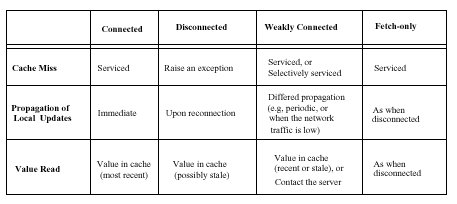
WC in Database Systems
Approaches
- the mobile host simply submits operations to be executed on a server or an agent at the fixed network [36, 84, 16]. either operations of a transaction sequentially one at a time - database processing locally at the mobile host raises physical database design issues, e.g., how to appropriately fragment the
database and allocate fragments at fixed and mobile hosts
Mobile Transactions
distributed transactions that involve both mobile and fixed hosts - traditional approaches (locks or timestamps) - opennested transaction models Weak and Strict Transactions Two types of copies: weak copies and strict copies. Weak transactions local to a
mobile host and update weak copies, strict transactions access strict copies. Weak copies are integrated with strict when connectivity improves or to enforce an applicationdefined limit to the allowable deviation among copies.
Strict transactions are slower than weak transactions but guarantee permanence of updates and currency of reads. Adaptability by adjusting the number of strict
transactions or the degree of divergence among copies. During disconnection, only weak transactions. Bayou Peertopeer architecture with a number of replicated servers weakly connected to
each other. Readany and writeany available copy Writes are propagated to other servers during pairwise contracts called antientropy sessions.
Sessions instead of transactions: a session is a sequence of read and write operation. Session guarantees to avoid inconsistencies when accessing copies at different servers; e.g.,, read operations reflect previous writes.
Adaptivity by individually selectable session guarantees, choices of committed or tentative data, age parameters on reads. Arbitrary disconnections
Complex Data Items
Split large or complex objects into smaller fragments, so that operation at each of the fragments can proceed relatively independently [45, 79]. Site escrow methods The fragmentation approach
Distributed Object Repositories
Organize data items as a collection of objects. Objects become the unit of caching and replication. Very flexible, e.g, objects can encapsulate conflict resolution procedures. Can be built on top of an existing system. In Rover
In the Promotion infrastructure
(e.g., number of accesses to the object), consistency rules to guarantee consistency, and obligations (such as deadlines).
WC in WebBased Systems
- Server Cache A cache at the fixed network in addition to the client's cache.
Prefetching at this cache hides some latency without affecting the wireless link. Can facilitate userspecified data reductions. E.g.,, a filtering script that selects
documents that match some criteria written by the user at the palmtop - Distillation and Refinement
Inline graphics add to the latency of loading web pages Distillation An agent proxy, called Pythia distills and forwards an image to the client, and then
caches a copy of the original image locally in case the client requests refinement. Users can register their capabilities with the Pythia proxy, thus distillation tuned towards their configuration or current connectivity. - Connection overhead Each request requires the browser to open a TCP/IP socket, this increases user response time and network traffic Thus, web prefetching or pipelining might cause more problems than benefits,
especially if usability of the prefetched objects is low. A single, longlived TCP/IP connection between the mobile browser and the fixed network - Differencing
Takes advantage of the fact that only small parts of cached objects are modified When an application requests an object, the object is cached at both the client and the server. Both cache a common base object.
When a client requests an outdated cached object (an object whose coherency interval has expired), the request is directed to the server's cache. If this also outdated, then to the web server for a fresh copy.
The server computes the difference between its local copy and the response and sends the difference to the client. The client merges the difference with its cached object to create the browser's response. -
Prefetching and Pipelining. Pipelining: a form of prefetching A modification of the GET method, called GETALL. GETALL: request from the web server to send not only the requested document, but also all of its inline images
residing on that server. GETLIST: selectively request a set of documents or images from the server (i.e., request those documents that are not in cache) An HTTP batch get Dynamic sets 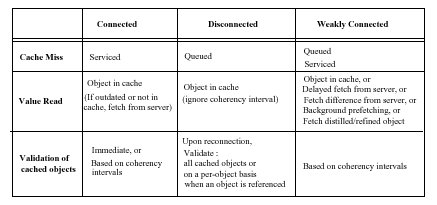
Mobility
Algorithms for dynamic data and task distribution
Placing Data
Variety of Approaches: In Whether to maintain or not a (readonly) local copy of an item Three alternative locations for placing copies: the server, the mobile client, and the location servers for the client Dynamic algorithms for replicated data placement simply by letting transactions update the directory
Moving Computations
Issues
- transparently from the associated application or be applicationaware - locationdependent or locationindependent (this case includes moving computation on and off a mobile client)
- after a unit of computation has been completed (e.g., after the transmission of a particular URL request or a transaction) OR while still in progress
- transmit also context: enough information so that the computation can continue correctly - How often does a computation move? Involves various costs, including the cost of transferring the context and of informing
other sites about the movement. Mobility in the Various Models Service handoff. Surrogate vs Servicespecific. In mobile agents, the programming language or the operating system provides
primitives to create and move agents. Tcl
Failure Recovery
Emphasis on recording consistent global checkpoints [59, 65, 1]
Main issues under consideration:
Checkpoint protocols A global state includes the state of each process participating in the distributed application and possibly some messages. A global checkpoint GlCkpt
is defined For correct recovery, the protocol must save a recoverable consistent global state. Consistency
: A global checkpoint is "consistent" if the following condition holds: for any message m, if rcv(m) is included in the checkpoint GlChkt , then send(m) is also included in the checkpoint.
Recoverability: To avoid loss of intransit messages, that is messages that were sent but not received by any other process, if the GlChkt contains the send(m) event but not the rcv(m)
event then the checkpoint protocol must save message m as well. Protocols classified into: Coordinated protocols Uncoordinated protocols Coordinated Protocols and Mobility
Uncoordinated Protocols and Mobility
Soft vs Hard Failures Soft failures: do not permanently damage the mobile host, such as battery discharge or operating system crashes Hard failures are handled by hard checkpoints
that are stored on the fixed network, while soft failures are dealt by soft checkpoints that are stored locally on the mobile host. Locally stored checkpoints do not consume bandwidth, are easily created and allow
the mobile host to continue functioning during disconnections.
the MH mobile host might move to another cell before the checkpointing process
is completed
[37], to gather information about other participants [17], or to
garbagecollect stored information [81].
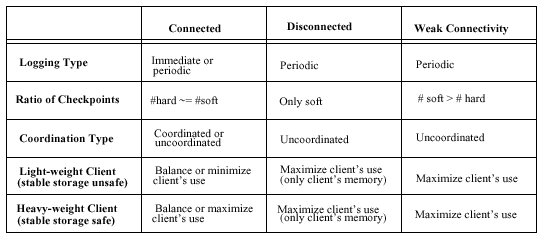
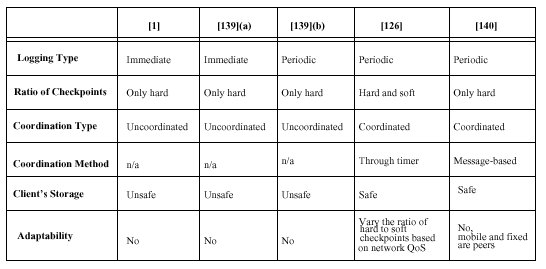
References
[1] A. Acharya and B. R. Badrinath. Checkpointing Distributed Applications on Mobile Computers. In Proceedings of the 3rd International Conference on Parallel and Distributed Information Systems, pages 73--80, Austin, Texas, September 1994.
[2] G. Alonso, G. Gunthor, M. Kanath, D. Agrawal, A. El. Abbadi, and C. Mohan. Exotica/FMDC: A Workflow Management System for Mobile and Disconnected Clients. Distributed and Parallel Databases, 4:27--45, 1996.
[3] B. R. Badrinath and T. Imielinski. Replication and Mobility. In Proceedings of the 2nd IEEE Workshop on the Management of Replicated Data, pages 9--12, November 1992.
[4] B. R. Badrinath and S. Phatak. Database Server Organization for Handling Mobile Clients. Technical Report DCS342, Department of Computer Science, Rutgers University, 1997.
[5] Bandwidth Conservation Society. Bandwidth Conservation Society's Homepage. www.infohiway.com/faster/.
[6] D. Barbar'a. Certification Reports: Supporting Transactions in Wireless Systems. In Proceedings of the IEEE International Conference on Distributed Computing Systems, 1997.
[7] D. Barbar'a and H. GarciaMolina. Replicated Data Management in Mobile Environments: Anything New Under the Sun? In Proceedings of the IFIP Conference on Applications in Parallel and Distributed Computing, April 1994.
[8] D. Barbar`a, S. Mehrota, and M. Rusinkiewics. INCAs: Managing Dynamic Workflows in Distributed Environmnets. Journal of Database Management, 7(1):5--15, 1996.
[9] T. BernersLee, R. Caililiau, A. Luotonen, H.F. Nielsen, and A. Secret. The WorldWide Web. Communications of the ACM, 37(8):76--82, August 1994.
[10] L. Cardelli. A Language with Distributed Scope. Computing Systems, 8(1):27--59, 1995.
[11] L. Cardelli. Mobile Computation. In J. Vitek and C. Tschudin, editors, Mobile Computation. In Mobile Object Systems Towards the Programmable Internet, pages 3--6. SpingerVerlag, LNCS 122, 1997.
[12] K. M. Chandy and L. Lamport. Distributed Snaphots: Determining Global States of Distributed Systems. ACM Transactions on Computer Systems, 3(1):63--75, February 1985.
[13] P. K. Chrysanthis. Transaction Processing in Mobile Computing Environment. In Proceedings of the IEEE Workshop on Advances in Parallel and Distributed Systems, pages 77--83, Princeton, New Jersey, October 1993.
[14] S. B. Davidson, H. GarciaMolina, and D. Skeen. Consistency in Partitioned Networks. ACM Computing Surveys, 17(3):341--370, September 1985.
[15] A. Demers, K. Petersen, M. Spreitzer, D. Terry, M. Theimer, and B. Welch. The Bayou Architecture: Support for Data Sharing Among Mobile Users. In Proceedings of the IEEE Workshop on Mobile Computing Systems and Applications, pages 2--7, Santa Cruz, CA, December 1994.
[16] M. Dunham, A. Helal, and S. Balakrishnan. A Mobile Transaction Model that Captures both the Data and Movement Behavior. ACM/Baltzer Journal on Special Topics on Mobile Networks, 1997. To appear.
[17] E. N. Elmozahy, W. Zwuenepoel, and W. Manetho. Transparent Rollback Recovery with Low Overhead, Limited Rollback and Fast Output Commit. IEEE Transaction on Computers, 41(5):526--531, May 1992.
[18] A. Fox and E. A. Brewer. Reducing WWW Latency and Bandwidth Requirements by RealTime Distillation. In Proceedings of the 5th International World Wide Web Conference, Paris, France, May 1996.
[19] A. Fox, S. D. Gribble, E. A. Brewer, and E. Amir. Adapting to Network and Client Variability via OnDemand Dynamic Distillation. In Proceedings of the ASPLOSVII, Cambridge, MA, October 1996.
[20] S. Glassman. A Caching Relay for the World Wide Web. Computer Networks and ISDN Systems, 27(2), November 1994.
[21] J. Gosling, B. Joy, and G. Steele. The Java Language Specification. AddissonWesley, 1996.
[22] J. Gray, P. Helland, P. O' Neil, and D. Shasha. The Dangers of Replication and a Solution. In Proceedings of the ACM SIGMOD Conference, pages 173--182, Montreal, Canada, 1996.
[23] J. N. Gray. Notes on Data Base Operating Systems. In B. R. Graham and G. Seegmuller, editors, Operating Systems An Advanced Course. SpingerVerlag, LNCS 60, 1978.
[24] R. Gruber, F. Kaashoek, N. Liskov, and L. Shrira. Disconnected Operation in the Thor ObjectOriented Database System. In Proceedings of the IEEE Workshop on Mobile Computing Systems and Applications, Santa Cruz, CA, December 1994.
[25] R. G. Guy, J. S. Heidemann, W. Mak, T. W. Jr. Page, G. J. Popek, and D. Rothmeier. Implementation of the Ficus Replicated File System. In Proceedings of USENIX Conference, pages 63--71, 1990.
[26] J.S. Heidemann, T. W. Page, R. G. Guy, and G. J. Popek. Primarily Disconnected Operation: Experience with Ficus. In Proceedings of the 2nd Workshop on the Management of Replicated Data, November 1992.
[27] P. Honeyman and L. B. Huston. Communication and Consistency in Mobile File Systems. IEEE Personal Communications, 2(6), December 1995.
[28] B C. Housel, G. Samaras, and D. B. Lindquist. WebExpress: A Client/Intercept Based System for Optimizing Web Browsing in a Wireless Environment. ACM/Baltzer Mobile Networking and Applications (MONET), 1997. Special Issue on Mobile Networking on the Internet. To appear. Also, University of Cyprus, CSTR 9618, December 1996.
[29] Y. Huang, P. Sistla, and O. Wolfson. Data Replication for Mobile Computers. In Proceedings of the 1994 SIGMOD Conference, pages 13--24, May 1994.
[30] Y. Huang and O. Wolfson. Object Allocation in Distributed Databases and Mobile Computing. In Proceedings of the 10th International Conference on Data Engineering, pages 20--29, February 1994.
[31] L. Huston and P. Honeyman. Peephole Log Optimization. In Proceedings of the IEEE Workshop on Mobile Computing Systems and Applications, Santa Cruz, CA, December 1994.
[32] L. B. Huston and P. Honeyman. Disconnected Operation for AFS. In Proceedings USENIX Symposium on Mobile and LocationIndependent Computing, pages 1--10, Cambridge, Massachusetts, August 1993.
[33] L. B. Huston and P. Honeyman. Partially Connected Operation. Computing Systems, 4(8), Fall 1995.
[34] T. Imielinksi and B. R. Badrinath. Data Management for Mobile Computing. SIGMOD Record, 22(1):34--39, March 1993.
[35] R. Jain and N. Krishnakumar. Network Support for Personal Information Services for PCS Users. In Proceedings of the IEEE Conference on Networks for Personal Communications, March 1994.
[36] J. Jing, O. Bukhres, and A. Elmagarmid. Distributed Lock Management for Mobile Transactions. In Proceedings of the 15th IEEE International Conference on Distributed Computing Systems, May 1995.
[37] D. B. Johnson and W. Zwuenepoel. Recovery in Distributed Systems using Optimistic Message Logging and Checkpointing. Journal of Algorithms, 11(3):462--491, September 1990.
[38] A. D. Joseph, A. F. deLespinasse, J. A. Tauber, D. K. Gifford, and M. F. Kaashoek. Rover: A Toolkit for Mobile Information Access. In Proceedings of the 15th Symposium on Operating Systems Principles, December 1995.
[39] A. D. Joseph, J. A. Tauber, and M. F. Kaashoek. Mobile Computing with the Rover Toolkit. IEEE Transactions on Computers, February 1997.
[40] T. Juang and S. Venkatesan. Crash Recovery with Little Overhead. In Proceedings of the 11th IEEE International Conference on Distributed Computing Systems, 1991.
[41] M. Frans Kaashoek, Tom Pinckney, and Joshua A. Tauber. Dynamic Documents: Mobile Wireless Access to the WWW. In Proceedings of the IEEE Workshop on Mobile Computing Systems and Applications, Santa Cruz, CA, December 1994.
[42] J. J. Kistler and M. Satyanarayanan. Disconnected Operation in the Coda File System. ACM Transactions on Computer Systems, 10(1):213--225, February 1992.
[43] J. Klingemann, T. Tesch, and J. Wasch. Enabling Cooperation among Disconnected Mobile Users. In Proceedings of the 2nd IFCIS International Conference on Cooperative Information Systems (CoopIS'97), June 1997.
[44] N. Krishnakumar and A. Bernstein. High Throughput Escrow Algorithms for Replicated Databases. In Proceedings of the 18th VLDB Conference, pages 175--186, August 1992.
[45] N. Krishnakumar and R. Jain. Mobility Support for Sales and Inventory Applications. In T. Imielinski and H. Korth, editors, Mobile Computing, pages 571--594. Kluwer Academic Publishers, 1995.
[46] G. H. Kuenning. The Design of the Seer Predictive Caching System. In Proceedings of the IEEE Workshop on Mobile Computing Systems and Applications, Santa Cruz, CA, December 1994.
[47] P. Kumar and M. Satyanarayanan. Logbased Directory Resolution in the Coda FIle System. In Proceedings of the 2nd International Conference on Parallel and Distributed Information Systems, San Diego, CA, January 1993.
[48] P. Kumar and M. Satyanarayanan. Flexible and Safe Resolution of File Conflicts. In Proceedings of the USENIX Winter 1995 Conference, New Orleans, LA, January 1995.
[49] B. W. Lampson. Atomic Transactions. In B. W. Lampson, editor, Distributed Systems: Architecture and Implemementation, pages 246--285. SpingerVerlag, LNCS 105, 1981.
[50] M. Liljberg, T. Alanko, M. Kojo, H. Laamanen, and K. Raatikainen. Optimizing WorldWide Web for Weakly Connected Mobile Workstations: An Indirect Apprach. In Proceedings of the SDNE, Whistler, Canada, June 1995.
[51] G. Y. Liu, A. Marlevi, and G. Q. Maguire Jr. A Mobile VirtualDistributed System Architecture for Supporting Wireless Mobile Computing and Communications. Wireless Networks, 2:77--86, 1996.
[52] Q. Lu and M. Satyanarayanan. IsolationOnly Transactions for Mobile Computing. Operating Systems Review, pages 81--87, April 1994.
[53] Q. Lu and M. Satyanarayanan. Improving Data Consistency in Mobile Computing Using IsolationOnly Transactions. In Proceedings of the Fifth Workshop on Hot Topics in Operating Systems, Orcas Island, Washington, May 1995.
[54] R. Malpani, J. Lorch, and D. Berger. Making World Wide Web Caching Servers Cooperate. In Proceedings of the 4th International World Wide Web Conference, Boston, MA, December 1995.
[55] L. Mummert and M. Satyanarayanan. Large Granularity Cache Coherence for Intermittent Connectivity. In Proceedings of the 1994 Summer USENIX Conference, Boston, MA, June 1994.
[56] L. B. Mummert, M. R. Ebling, and M. Satyanarayanan. Exploiting Weak Connectivity for Mobile File Access. In Proceedings of the 15th ACM Symposium on Operating Systems Principles, December 1995.
[57] P. O' Neil. The Escrow Transactional Method. ACM Transactions on Database Systems, 11(4):405--430, 1986.
[58] N. Neves and W. K. Fuchs. Using Time to Improve the Performance of Coordinated Checkpointing. In Proceedings of the IEEE International Computer Performance and Dependability Symposium, pages 182--191, Urbana, Illinois, September 1996.
[59] N. Neves and W. K. Fuchs. Adaptive Recovery for Mobile Environments. Communications of the ACM, 40(1):69--74, January 1997.
[60] Oracle. Oracle Mobile Agents Technical Product Summary. www.oracle.com/products/networking/mobile agents/html/, June 1997.
[61] J. K. Ousterhout. Tcl and the Tk Toolkit. AddissonWesley, 1994.
[62] E. Pitoura. A Replication Schema to Support Weak Connectivity in Mobile Information Systems. In Proceedings of the 7th International Conference on Database and Expert Systems Applications (DEXA96), pages 510--520. LNCS 1134, Springer Verlag, September 1996.
[63] E. Pitoura and B. Bhargava. Maintaining Consistency of Data in Mobile Distributed Environments. In Proceedings of the 15th IEEE International Conference on Distributed Computing Systems, pages 404--413, May 1995.
[64] E. Pitoura, B. Bhargava, and O. Wolfson. Data Consistency in Intermittently Connected Distributed Systems. Technical Report DCS9610 (Revised 7/97), Department of Computer Science, University of Ioannina, 1997.
[65] D. K. Pradhan, P. P. Krishna, and N. H. Vaidya. Recovery in Mobile Wireless Environment: Design and Tradeoff Analysis. In Proceedings of the 26th IEEE International Symposium on FaultTolerance Computing, pages 16--25, Sendai, Japan, June 1996.
[66] R. Prakash and M. Sihghal. LowCost Checkpointing and Failure Recovery in Mobile Computing Systems. IEEE Transactions on Parallel and Distributed Systems, 7(10), October 1996.
[67] V. N. Radmanabhan and J. C. Mogul. Improving HTTP Latency. Computer Networks and ISDN Systems, 28(1), December 1995.
[68] P. Reiher, J. Popek, M. Gunter, J. Salomone, and D. Ratner. PeertoPeer Reconiliation Based Replication for Mobile Computers. In Proceedings of the European Conference on Object Oriented Programming 2nd Workshop on Mobility and Replication, June 1996.
[69] G. Samaras, K. Britton, A. Citron, and C. Mohan. TwoPhase Commit Optimizations in a Commercial Distributed Environment. Distributed and Parallel Databases, 3(4):325--361, October 1995.
[70] G. Samaras and S. D. Nikolopoulos. Algorithmic Techniques Incorporating Heuristic Desicions in Commit Protocols. In Proceedings of the 25th IEEE Euromicro Conference, September 1995.
[71] D. Skeen. Nonblocking Commit Protocols. In Proceedings of the ACM/SIGMOD International Conference on Management of Data, pages 133--142, Ann Arbor. Michigan, 1981.
[72] D. Steere and M. Satyanarayanan. Using Dynamic Sets to Overcome High I/O Latencies During Search. In Proceedings of the 5th IEEE HotOS Conference, May 1995.
[73] R. E. Strom and S. Yemini. Optimistic Recovery in Distributed Systems. ACM Transactions on Computer Systems, 3(3), 1985.
[74] C. Tait, H. Lei, S. Acharya, and H. Chang. Intelligent File Hoarding for Mobile Computers. In Proceedings of the 1st ACM International Conference on Mobile Cmputing and Networking (Mobicom'95), Berkeley, Ca, October 1995.
[75] C. D. Tait and D. Duchamp. Service Interface and Replica Management Algorithm for Mobile File System Clients. In Proceedings of the First International Conference on Parallel and Distributed Information Systems, pages 190--197, 1991.
[76] C. D. Tait and D. Duchamp. An Efficient VariableConsistency Replicated File Service. In Proceedings of the USENIX File Systems Workshop, pages 111--126, May 1992.
[77] D. Terry, A. Demers, K. Petersen, M. Spreitzer, M. Theimer, and B. Welch. Session Guarantees for Weakly Consistent Replicated Data. In Proceedings of the International Conference on Parallel and Distributed Information Systems, pages 140--149, September 1994.
[78] D. B. Terry, M. M Theimer, K. Petersen, A. J. Demers, M. J Spreitzer, and C. H. Hauser. Managing Update Conflicts in Bayou, a Weakly Connected Replicated Storage System. In Proceedings of the 15th ACM Symposium on Operating Systems Principles, December 1995.
[79] G. Walborn and P. K. Chrysanthis. Supporting SemanticsBased Transaction Processing in Mobile Database Applications. In Proceedings of the 14th Symposium on Reliable Distributed Systems, September 1995.
[80] G. Walborn and P. K. Chrysanthis. PROMOTION: Support for Mobile Database Access. Personal Technologies Journal, 1(3), September 1997.
[81] Y. M. Wang and W. K. Fuchs. Optimistic Message Logging for Independent Checkpointing in MessagePassing Systems. In Proceedings of the 11th IEEE Symposium on Reliable Distributed Systems, pages 147--154, Houston, Texas, October 1992.
[82] T. Watson. Application Design for Wireless Computing. In Proceedings of the First IEEE Workshop on Mobile Computing Systems and Applications, Santa Cruz, California, December 1994.
[83] J. E. White. Mobile Agents. General Magic White Paper, www.genmagic.com/agents, 1996.
[84] L. H. Yeo and A. Zaslavsky. Submission of Transactions from Mobile Workstations in a Cooperative Multidatabase Processing Environment. In Proceedings of the 14th International Conference on Distributed Computing Systems, Poznan, Poland, June 1994.
[ Chapter 1 ] [ Chapter 2 ] [ Chapter 3 ] [ Chapter 4 ] [ Chapter 5 ] [ Chapter 6 ] [ Chapter 7 ] [ Index ]
[EPL651] [Course Contact] [Schedule & Readings] [Assignments] [Resources] [What's New]